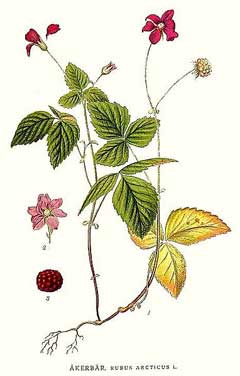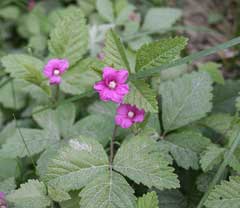 |
|
http://commons.wikimedia.org/wiki/File:310_Rubus_arcticus.jpg |
 |
| http://fi.wikipedia.org/wiki/K%C3%A4ytt%C3%A4j%C3%A4:Kompak |
Translate this page:
Summary
Also known as Nagoonberry in British Columbia. Fruit: Brownish purplish red, aromatic, sweet aggregate of drupes.
Physical Characteristics

 Rubus_arcticus is a PERENNIAL growing to 0.2 m (0ft 8in) by 1 m (3ft 3in).
Rubus_arcticus is a PERENNIAL growing to 0.2 m (0ft 8in) by 1 m (3ft 3in).
See above for USDA hardiness. It is hardy to UK zone 1. It is in flower from June to July, and the seeds ripen from July to August. The species is hermaphrodite (has both male and female organs) and is pollinated by Insects.
Suitable for: light (sandy), medium (loamy) and heavy (clay) soils and prefers well-drained soil. Suitable pH: mildly acid, neutral and basic (mildly alkaline) soils and can grow in very acid soils.
It cannot grow in the shade. It prefers moist soil.
UK Hardiness Map
US Hardiness Map
Synonyms
Rubus arcticus ssp. acaulis - (Michx.)
Plant Habitats
Edible Uses
Fruit - raw or cooked[2, 61, 105, 257]. Very sweet, juicy and palatable with a pineapple-like aroma[1, 101, 172, 183]. Delicious when eaten out of hand, they are also used in making cakes, jams etc[183]. Unfortunately, they are often not produced very prolifically in a garden situation in Britain, probably because they prefer colder winters. Flowers - raw. Sweet and delicious[172]. The fresh or dried leaves are used as a tea substitute[61, 105, 183].
References More on Edible Uses
Medicinal Uses
Plants For A Future can not take any responsibility for any adverse effects from the use of plants. Always seek advice from a professional before using a plant medicinally.
None known
References More on Medicinal Uses
The Bookshop: Edible Plant Books
Our Latest books on Perennial Plants For Food Forests and Permaculture Gardens in paperback or digital formats.

Edible Tropical Plants
Food Forest Plants for Hotter Conditions: 250+ Plants For Tropical Food Forests & Permaculture Gardens.
More

Edible Temperate Plants
Plants for Your Food Forest: 500 Plants for Temperate Food Forests & Permaculture Gardens.
More

More Books
PFAF have eight books available in paperback and digital formats. Browse the shop for more information.
Shop Now
Other Uses
A purple to dull blue dye is obtained from the fruit[168].
Special Uses
References More on Other Uses
Cultivation details
Easily grown in a good well-drained loamy soil in a sunny position[1, 11]. A very variable species, it is sometimes divided into three species, viz.:- R. arcticus, R. acaulis and R. stellatus[101]. Suitable for growing in containers. Most often in acidic soils rich in organic matter. Rubus arcticus subsp. x stellarcticus G.Larss. is an unresolved name
This name is unresolved, but some data suggest that it is synonymous with Rubus × stellarcticus (G.Larss.) H.E.Weber , but some data suggest that it is an infraspecific name of Rubus arcticus L..
References Carbon Farming Information and Carbon Sequestration Information
Temperature Converter
Type a value in the Celsius field to convert the value to Fahrenheit:
Fahrenheit:
The PFAF Bookshop
Plants For A Future have a number of books available in paperback and digital form. Book titles include Edible Plants, Edible Perennials, Edible Trees,Edible Shrubs, Woodland Gardening, and Temperate Food Forest Plants. Our new book is Food Forest Plants For Hotter Conditions (Tropical and Sub-Tropical).
Shop Now
Plant Propagation
Seed - requires stratification and is best sown in early autumn in a cold frame. Stored seed requires one month stratification at about 3°c and is best sown as early as possible in the year. Prick out the seedlings when they are large enough to handle and grow on in a cold frame. Plant them out into their permanent positions in late spring of the following year. Division in early spring or just before leaf-fall in the autumn[200]. Larger divisions can be planted out direct into their permanent positions. We have found it best to pot up the smaller divisions and grow them on in a lightly shaded position in a cold frame, planting them out once they are well established in the summer.
Other Names
If available other names are mentioned here
Native Range
TEMPERATE ASIA: Russian Federation-Western Siberia (Western Siberia), Russian Federation-Eastern Siberia (Eastern Siberia), Mongolia, Russian Federation-Far East (Far East), China (Heilongjiang Sheng, Jilin Sheng, Liaoning Sheng, Nei Mongol Zizhiqu), Korea NORTHERN AMERICA: Canada (Northwest Territories (west), Yukon, Alberta, British Columbia), United States (Alaska) EUROPE: Finland, Norway, Sweden, Russian Federation-European part (European part (north))
Weed Potential
Right plant wrong place. We are currently updating this section.
Please note that a plant may be invasive in one area but may not in your area so it’s worth checking.
Conservation Status
IUCN Red List of Threatened Plants Status : Least Concern

Growth: S = slow M = medium F = fast. Soil: L = light (sandy) M = medium H = heavy (clay). pH: A = acid N = neutral B = basic (alkaline). Shade: F = full shade S = semi-shade N = no shade. Moisture: D = dry M = Moist We = wet Wa = water.
Expert comment
Author
L.
Botanical References
43200235
Links / References
For a list of references used on this page please go here
Readers comment